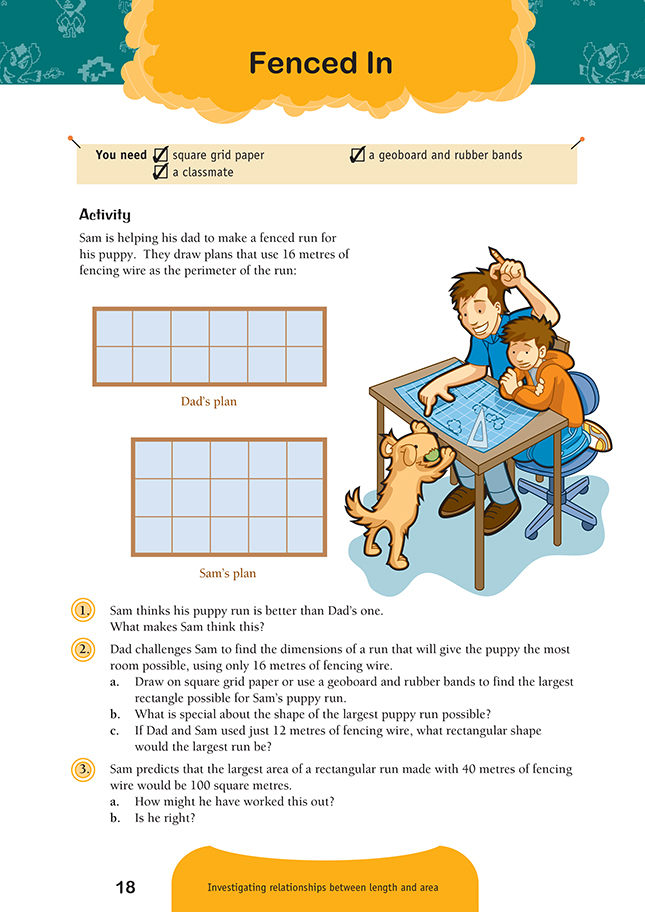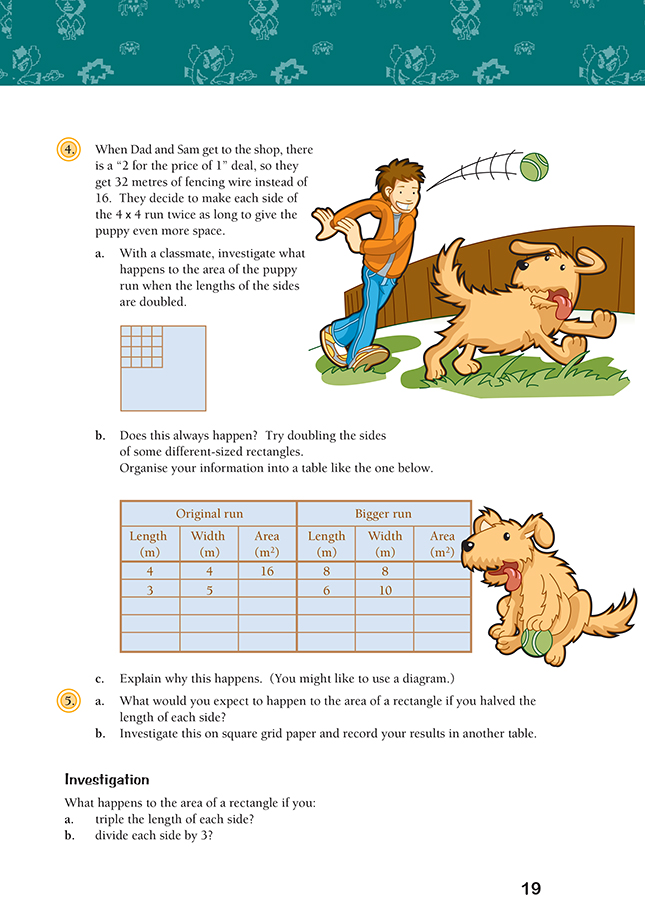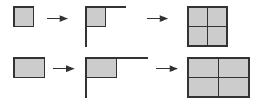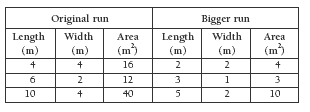This is a level 4 number activity from the Figure It Out series. It relates to Stage 7 of the Number Framework.
A PDF of the student activity is included.
Click on the image to enlarge it. Click again to close. Download PDF (419 KB)
use proportional adjustment to sovle multplication problems
FIO, Level 3, Number Sense and Algebraic Thinking, Book Two, Fenced In, pages 18-19
Square Grid paper
A geoboard and rubber bands
A classmate
In this activity, students explore how changes in the lengths of a rectangle’s sides affect its area. Encourage them to use multiplicative reasoning.
You may need to define these terms:
• Area: the size of a surface contained by a boundary, measured in squares.
• Perimeter: the length of a line that encloses a shape, in this case, the length of the fence around the outside of the puppy run.
• Rectangle: a 4-sided shape with 4 right-angled corners. (Note that this definition includes squares. All squares are rectangles, but not all rectangles are squares.)
In the activity, the students create rectangles on geoboards and find multiplicative strategies to count the squares, so they don’t need to know the formula for finding the area of a rectangle. If you don’t have access to geoboards and rubber bands, supply square grid paper that the students can either cut up or draw rectangles on. Geoboards are useful because the students can show clearly what happens when the sides of a rectangle are lengthened by stretching out a different-coloured rubber band over the top of the first one.
The aim of question 2 is for the students to recognise that the largest possible rectangular area that can be made with any particular perimeter will always have 4 equal sides. (Note that for this activity, the students are working only with multiples of 4, so there are no fractions to deal with.) Some students think that squares and rectangles are two different shapes, and so they won’t try a square on their geoboard because the question asks them to find the largest rectangle possible. If you notice this happening, encourage them to recognise that a square is actually a subset of the rectangle classification (a “regular” rectangle) by asking questions such as:
What special features does a rectangle have that make it a rectangle? (The students may find it helpful to look in the dictionary to add to their definition). As the students define each feature, make a list on the board. A possible definition is: A rectangle is a flat shape with 4 straight sides and 4 right-angled corners and 2 pairs of sides that are parallel (the lines go in the same direction).
Discuss which of these features stem from other features. For example, If the angles are right angles, is it possible for the pairs of sides to not be parallel? (No!) Try to arrive at the most important criterion, that is, having a 90° angle at each corner. Then get the students to apply the criterion to a square to see if it’s a kind of rectangle.
Does a square fit these criteria as well? Go down the list and tick each criterion off as the students agree that it does match. Tell the students that a square is a special sort of rectangle, just like an equilateral triangle is a special sort of triangle. It has all the same features as a rectangle plus one additional feature: all 4 sides are the same length.
In question 4, the students explore what happens to the area of a rectangle when the lengths of the sides are doubled. Encourage the students to show the comparison on their geoboard or paper by using different colours for the original rectangle and the enlarged one and displaying them both at once. They can make large rectangles by pushing a few geoboards together and then using several rubber bands stretched thin (or lengths of wool) to make each side. With a guided teaching group, you could ask each student to make a different-sized rectangle. Record the information about each student’s rectangle in a table as they share with the group and then compare the results.
The students should be able to identify a short cut for finding the area of a rectangle by looking for patterns, using the data generated in the table. To prompt them to identify the relationship between the length and width and the area, ask:
If you count 5 squares along the bottom row of a rectangle and 4 squares up the side, what’s a quick way of working out how many squares are in the whole rectangle?
“I saw that there were 4 rows, so I worked out 4 lots of 5 squares. 4 x 5 = 20 squares.”
Look at the numbers on your table in the length and width columns. How could you use the numbers 4 and 4 to make 16? How could you use the numbers 3 and 5 to make 15?
Does this work with the other rectangles on your table?
If you know that the length of a rectangle is 10 and its width is 5, how many squares would you predict there would be in its area?
Make sure that you connect the students’ multiplicative expressions with the origin of the factors, that is, the columns and rows in the rectangles.
Questions 4c and 5 are useful for formative assessment to evaluate whether the students can explain the relationship between the sides and the area when the sides are doubled or halved.
Investigation
Some students may like to extend the investigation by exploring what happens when the lengths of the sides are multiplied by 4 or divided by 4, multiplied by 5 or divided by 5, and so on.
Ask: Can you find a way to use square numbers (22 = 4, 32 = 9, 42 = 16, 52 = 25, and so on) to predict what will happen to the area of a rectangle if the sides are multiplied by 10 or divided by 10?
Answers to Activity
1. Sam’s run has a bigger area for the puppy to run in: his run is 15 m2 (5 x 3) compared with Dad’s 12 m2 (6 x 2).
2. a. Practical activity. The largest run possible has an area of 16 m2
.gif)
b. The largest rectangle is actually a square (all the sides are the same length).
c. A square. It would have sides of 3 m, and its area would be 9 m2 .
3. a. He might have gone 40 ÷ 4 = 10 and 10 x 10 = 100.
b. Yes.
4. a. The area gets 4 times bigger. (8 x 8 = 64; 64 = 16 x 4)
b. Yes, it always happens. A possible table is:
.gif)
c. When the sides of a rectangle are made twice as long, you can fit 4 of the original rectangles in the new rectangle. Possible diagrams include:
5. a. The area would get 4 times smaller.
b. Practical activity. Lengths used will vary. Some examples are:
Investigation
a. It gets 9 times bigger (see diagram).
b. It gets 9 times smaller.




